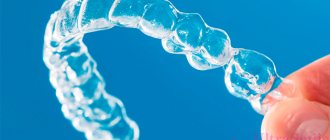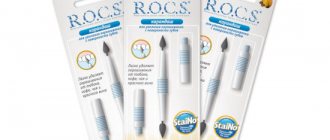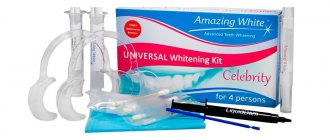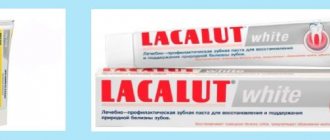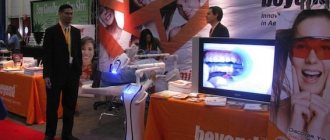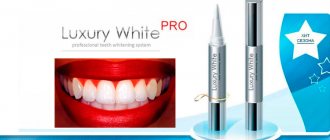A beautiful smile can be called the calling card of modern people. You can make your teeth snow-white using special cold lamps. Professional light whitening provides the best results.
Interesting! Teeth whitening (not cold, of course) was invented in ancient Egypt. The Egyptians ground pumice and wine vinegar. Or they used improvised tools like a file. Yes, the teeth undoubtedly became lighter, but after a while they were affected by caries, because under the influence of acid and abrasive particles of pumice the enamel was quickly and severely destroyed. And the files completely removed the top layer.
Modern photobleaching technologies do not involve the use of improvised means and are based on the use of hydrogen peroxide and a cold beam of light.
This is one of the photobleaching methods
Photo whitening allows you to radically transform your smile in just one visit to the dentist. The technology is also called “light”, since during its implementation the doctor acts on the tooth pigment through lamps emitting cold or hot light.
The principle of removing pigment from enamel is similar in all photobleaching methods. It is assumed that a gel with hydrogen peroxide or urea (reagent) and light (catalyst) will be used. Under the influence of a light lamp, the gel releases active oxygen, which penetrates deep into the tissue and removes pigment.
Sequencing
Regardless of which system the procedure will be performed, cold whitening technology includes the following sequential stages of the dentist’s actions:
- The gel composition is carefully applied to the surface of the jaw row and evenly distributed - this is an active brightener;
- turn on the lamp and direct it to the frontal smile area . Typically, such radiation exposure lasts from 10 to 15 minutes;
- after this, the specialist evaluates the result and, if necessary, carries out several more series of surface treatments with a lamp;
- At the end of the manipulation, the remaining gel is removed , and the patient is given detailed advice and recommendations for further dental care.
If a poor result is obtained, a repeat session can be performed no earlier than after 7-10 days.
The video shows the process of the procedure.
Carried out using halogen lamps
Cold teeth whitening involves the use of a gel activated by halogen lamps, the radiation of which is passed through special filters. As a result, the teeth are exposed to high-intensity, cool blue light.
Halogen lamps have the least negative effect on enamel
It is believed that halogen lamps have the least negative effect on the enamel and do not cause pain during and after the procedure. During operation, they do not heat tissues, as do ultraviolet and LED devices used, for example, for ZOOM technology, which also belongs to the category of photo-bleaching. However, the same “ZOOM” has its own advantages, because the developer has created a gel for these lamps, which contains components that strengthen and reduce the increased sensitivity of the enamel.
Cold light is light that does not have ultraviolet or infrared radiation; its temperature is approximately 37 ° C (almost the same as that of the human body). Due to this temperature regime, the procedure is as comfortable and painless as possible for the patient.
Techniques
All technologies used in domestic clinics are foreign developments and equipment.
Unfortunately, we don’t yet have our own analog systems—hence the high cost of the service. Let's consider the most popular systems:
- Beyond Polus – created using unique Light Bridge technology.
It is based on the use of halogen lamps. This eliminates the negative impact on the patient’s body of ultraviolet radiation used during standard enamel lightening. Moreover, it does not heat the surface and ensures the most uniform distribution of the composition; - Luma Cool is the most famous and popular system in Europe, but extremely limited here. It is the only patented technology in the world that allows you to use diode lamps rather than halogen lamps during a session.
- Amazing White – a novelty in the world of dentistry. Activates chemical processes thanks to the LED lamp.
The assortment line of this product is so diverse that it offers the consumer mini-kits for home use.Undoubtedly, their effectiveness will be an order of magnitude lower than salon whitening, but they are quite suitable as intermediate procedures. Representatives of this brand are systems with violet, red and blue light fluxes.
The purpose of determining the oral hygiene index and the methods used.
In this publication, read about the method of intra-canal teeth whitening.
Here https://www.vash-dentist.ru/krasota-i-uxod/otbelivanie/poloski/yotuel-razrabotka-po-evropeyskim-standartam.html all the most important things about Yotuel whitening.
Gentle on enamel and gums, does not cause pain
Experts say that teeth whitening with cold light eliminates the possibility of injury, overheating and overdrying of hard tissues, as well as increased enamel sensitivity after the procedure. When carrying out manipulations there is no risk of burns or irritation of the mucous membrane.
Cold whitening is a gentle method
“I’ve been wanting to try cold whitening for a long time. True, because of the name, I was afraid that the cold would set my teeth in the process, but it turned out that this was not the case at all. During the procedure, I very carefully monitored the sensations that arose: when the gel was applied, I felt a slight tingling sensation, but I did not have any direct pain or cramps. Everything is tolerant and acceptable! On the first day, of course, my teeth ached, there’s no way around it, but less than with chemical whitening, which I did before. By the second day I already felt completely fine.”
Viki_Niki, review from otzovik.com
Indications and restrictions
Indications for the cold whitening procedure are visible darkening, change in shade, pigmentation of tooth enamel, both general and fragmented.
Darkening can be caused by the negative influence of nicotine tar, tea, coffee, drinks and juices. Often the cause of color loss is poor oral hygiene, and, as a result, plaque and tartar.
In addition, the patient may be recommended this method as an alternative option to give a snow-white appearance to teeth that naturally have a yellowish or gray tint. True, the effect in this case may be less pronounced.
Despite the almost absolute safety of the technique for the human body, it is not recommended, and sometimes even extremely undesirable, in the following situations:
- pregnancy at all stages of its course;
- lactation period;
- age restrictions - too young or, on the contrary, old age of the patient. This can damage the structural integrity of the enamel, which is not yet sufficiently formed during childhood, and is physiologically weakened in old age;
- tendency of teeth to wear out;
- in the presence of diabetes mellitus;
- in case of respiratory dysfunction;
- when diagnosing neoplasms of a malignant nature of formation - regardless of the degree and stage of disease progression;
- with a tendency to intolerance to certain groups of medications;
- dental diagnoses, such as caries;
- partial destruction of the surface layer of hard organ tissue;
- a large number of fillings, dentures, crowns and implantation systems - artificial materials after bleaching will not turn white, but will retain their original color and will be noticeable against the background of general bleaching. They will need to be changed;
- pathologically thin enamel - if this fact is ignored, the tooth may begin to decay.
What is the Doctor Smile whitening procedure and the equipment used.
Come here if you are interested in the essence of Zoom 4 teeth whitening.
At this address https://www.vash-dentist.ru/krasota-i-uxod/otbelivanie/osobennosti-double-white.html we’ll talk about the pros and cons of Double White express teeth whitening.
Will not cope with hypoplasia and fluorosis
The technology will not be effective against non-carious lesions and stains that affect the aesthetics of the smile: hypoplasia, fluorosis, wedge-shaped defect. Especially if the pathologies are severe.
Are any of the professional whitening methods effective for the listed defects? Researchers claim that some types of hypoplasia, mild fluorosis and even tetracycline teeth are best treated with ZOOM technology. But most often, such patients are still offered to install veneers, lumineers and crowns (if the teeth are severely damaged), which, in addition to adding aesthetics to the smile, help protect the enamel from external influences, destruction and caries.
The technology will not be effective against fluorosis
Expected Result
Experts claim a fairly effective range of enamel lightening - from 6 to 10 tones, especially since if the result is poor, the manipulation can be repeated, and the number of sessions per visit can be increased.
Organs whose color is not snow-white due to genetics are somewhat less susceptible to bleaching. Naturally gray or yellow teeth are the most difficult to lighten.
The result is stored for about a year, after which the process can be repeated.
Allows you to lighten teeth by 6–10 shades
Teeth whitening without heat or laser is safer than with it. However, the effect of using this technology will not be so impressive: not 8–12, but 6–10 tones. The maximum positive result can be achieved if darkening or yellowing of the enamel was caused by smoking, consumption of food and drinks with dyes, or age-related changes.
Some doctors do not advise teeth whitening with cold light if the enamel has a natural gray tint, because then the maximum that can be achieved will be only 2-3 tones.
A smile can be lightened by 6–10 tones
Preparation for the procedure
Whitening with gel and LED lamp is carried out only in dental clinics. Portable compact devices for home use have not yet been created.
Important! A week before lamp bleaching, it is not recommended to consume foods and drinks that contain natural dyes - coffee, wine, sweet soda, berries, sauces, seasonings, beets, carrots.
Stages:
- The first step is thorough cleaning of the oral cavity: existing plaque is removed from the teeth. Otherwise, whitening will occur not of the teeth, but of the plaque. At this stage, doctors perform fluoridation using special preparations that create a protective film on the tooth and strengthen the enamel. One of the most common methods of removing plaque is the Air-Flow sandblasting technique.
- Then the dentist will select the shade of enamel according to the Vita scale, depending on your wishes.
- The next stage is to isolate the lips and cheeks from the teeth using special wipes and cream.
- To protect the gums from the effects of the chemically active gel, a liquid cream is used, which hardens after application and forms a protective barrier.
Brush your teeth with fluoride toothpaste once a day, as high fluoride content can lead to fluorosis. That is, for example, at night you should brush your teeth with a fluoride-containing paste, and in the morning with a paste containing extracts of medicinal herbs.
Cold teeth whitening techniques
Amazing White: this is one of the most popular and safest methods today, allowing you to lighten the enamel by 6-10 tones. At the same time, dentists who use the technique in their practice assure that you will get a natural color, and there is no risk of unnatural whiteness.
Amazing White is one of the most popular whitening methods
Beyond Polus: allows you to whiten teeth in different clinical cases, since the device designed for the procedure has several operating modes (soft, normal and intensive). According to a number of studies2, Beyond lamps emit minimal heat compared to similar devices from other manufacturers. Beyond International also offers patients the opportunity to purchase a halogen lamp for home use, but more details about this and much more can be found in the feature article on the website.
Beyond lamps produce minimal heat
Luma-Arch (“Luma Arch”): using this method you can lighten the enamel by 6-8 tones. To do this, you will only need to make 1 visit to the dentist and spend about 30 minutes (the teeth are lightened in three approaches of 8 minutes each). The method is not as popular in Russia as the others that were listed earlier.
Notice
: Undefined variable: post_id in
/home/c/ch75405/public_html/wp-content/themes/UltraSmile/single-item.php
on line
45 Notice
: Undefined variable: full in
/home/c/ch75405/public_html/wp-content /themes/UltraSmile/single-item.php
on line
46
Rate this article:
( 1 ratings, average: 5.00 out of 5)
whitening
- Androsenko N.I. Comparative characteristics of teeth whitening methods in therapeutic dentistry // Bulletin of medical Internet conferences. – 2022.
- Lutskaya I.K. Current state of the problem of teeth whitening // International reviews: clinical practice and health. – 2022.
Expert “Teeth whitening with cold light is one of the safest technologies. But this does not negate careful preparation for the procedure, including professional oral hygiene, strengthening the enamel through fluoridation and remineralization, and the use of special pastes that reduce the sensitivity of hard tissues. It is also necessary to exclude contraindications: age under 18 years, multiple caries, acute inflammation of the gums, oncology, a large number of fillings or the presence of artificial crowns in the smile area.” Dental hygienist Victoria Nikolaevna Kashaeva
Consulting specialist
Kashaeva Victoria Nikolaevna
Specialization: Dental hygienist Experience: 8 years
How it all happens
The procedure is carried out using a lamp and gel:
- The surface of the teeth becomes dry.
- Then it is processed with a lamp.
- If all teeth are whitened, the exposure time is about 30 minutes.
- The dentist then turns off the lamp, removes the gel, and you evaluate the results.
If for some reason you don’t like the result, the procedure is repeated. During one visit to the dental office, you may undergo up to 3 cold light whitening procedures.
Comments
There is a filling on the front tooth, will it be whitened using the methods you listed?
Valya (06/08/2020 at 01:15) Reply to comment
- Dear Valya, fillings and artificial crowns cannot be whitened by any of the methods existing today. If you want to whiten the enamel, then the filling will need to be changed so that it matches the color of the new shade of the teeth.
Editorial staff of the portal UltraSmile.ru (06/13/2020 at 09:15) Reply to comment
Is it possible to do cold bleaching immediately after air flow?
Laura (06/27/2020 at 01:24 pm) Reply to comment
- No, you need to wait at least 7–10 days: during this period you need to use special pastes and remineralizing compounds.
Editorial staff of the portal UltraSmile.ru (07/03/2020 at 09:47) Reply to comment
Will they give me an anesthetic injection before bleaching, otherwise I’m afraid...
Zverev S. (07/13/2020 at 15:47) Reply to comment
- Injection anesthesia is not used for such a procedure, but the gums and soft tissues will be treated with a special protective gel that reduces sensitivity and the likelihood of irritation of the mucous membrane.
Editorial staff of the portal UltraSmile.ru (07/17/2020 at 09:08) Reply to comment
Write your comment Cancel reply
Doctor Zubastic recommends
By following simple rules, you can save the result for a long time:
- After the cold beam whitening procedure, you cannot lighten your teeth at home with hydrogen peroxide, salt, soda, or other folk remedies. This leads to damage to the enamel.
- If you cannot stop drinking coffee, red wine and foods containing dyes, brush your teeth after every meal. No opportunity? Use special mouth rinses, sprays, and irrigators. This will help prevent the formation of plaque and stone, which are precursors to darkening of the enamel. This also applies to those people who smoke. Under the influence of nicotine, even lightened enamel will turn yellow.
- Be sure to cleanse your mouth twice a day – morning and evening.
- Visit the dentist once every six months.
- Don't use toothpicks. An alternative to them is dental floss.
- Eat less foods containing sugar. They contribute to the proliferation of bacterial infections in the oral cavity.
- Include green apples and dairy products - cottage cheese, milk, cheese - in your diet. They are rich in calcium, which will help strengthen dental tissue.
Only careful oral care, diet and your efforts will help you maintain a Hollywood smile for a long time.
Tags: Amazing White, Beyond, LED lamp, Luma Cool, lamp whitening, whitening, photo whitening
About the author: Dr. Zubastik
Typically, a toothache begins to subside on the way to the clinic and finally goes away after 10 minutes of sitting in line to see the dentist.
- Related Posts
- What kind of crowns are placed on the front teeth?
- How to rinse your mouth with chlorhexidine?
- The best toothpastes for tartar: top 10
« Previous entry
Prices
The cost of a service is difficult to determine unambiguously - even the region of residence of the patient and the status of the clique play a significant role in the issue of pricing.
The determining factor is the technique used during the session:
- Beyond Polus – 10-18 thousand rubles;
- Luma Cool – 8000—22000;
- Amazing White – 11 thousand.
In addition, the entire range of preliminary manipulations is not included in the total cost of the service - you will have to pay for them separately, depending on the volume of work performed.
Cholisal: how to take the drug correctly
Cholisal is a drug that has anti-inflammatory, analgesic and antimicrobial effects.
Release form
The drug is available in the form of a dental gel, which is used during teething. It has a specific smell.
Components
Active elements: choline salicylates and cetalkonium chloride. There are also additional ingredients: ethanol, anise seed oil.
Pharmacology and pharmacodynamics
The gel helps fight inflammation, relieves pain and has an antimicrobial effect.
The active substance perfectly anesthetizes the area to which the gel was applied and eliminates inflammation. The analgesic effect lasts for 3-8 hours. Another active component has an antiseptic effect, killing harmful microorganisms.
The medicine has a certain structure, due to which it penetrates well into the tissue and remains on the oral mucosa for several hours. Almost does not enter the blood circulation.
When to use
The gel is prescribed in the following cases:
damage to the integrity of the mucosa due to the use of prostheses or as a result of mechanical impact;
pain relief after dental surgery;
when teething in babies;
other damage and inflammatory processes in the oral mucosa.
How to take it correctly
The instructions say that the ointment is used only topically. The gel should be applied to the problem area and left for 15 minutes. Can be applied at any time, regardless of meals. The procedure can be performed up to 3 times a day. For an adult, 1 cm of gel will be enough; for a child, you need to take 2 times less.
If a person suffers from periodontal disease, then the ointment can be placed in the gum pocket that appears, or compresses can be made from a medicine for the gums.
Contraindications
The drug has a minimal number of contraindications. These include:
allergic reaction (most often caused by the constituent components of the product);
age up to 1 year;
breastfeeding period.
Adverse reactions and overdose
In rare cases, side effects may occur. A tingling or burning sensation may be felt at the sites where the ointment is applied. This reaction usually disappears after a few minutes. Various allergies may also appear.
No cases of overdose have been identified to date. The gel does not need to be swallowed, only used topically. If there is a lot of ointment on the mucous membrane, then you need to rinse your mouth well. If the composition gets into the gastrointestinal tract, you need to rinse the stomach. Treatment is carried out taking into account the existing symptoms.
Is Cholisal possible for children under one year old?
The instructions say that the drug is contraindicated for use in children under one year of age. If a child has stomatitis, then you can apply the ointment to the damaged areas half an hour before meals. Or rub in 0.5 cm of gel for 2-3 minutes.
Is it possible to use Cholisal during pregnancy and lactation?
The instructions say that the drug should not be used by pregnant and breastfeeding women. But in rare cases, a doctor may prescribe a remedy. It can only be used as prescribed by a doctor and under his constant supervision.
special instructions
Shelf life – 36 months. It must be kept in a place where children have no access. The temperature should be 0…+25 degrees. The ointment should not be allowed to freeze.
At acceptable doses, there is no interaction with other drugs. If you exceed the dosage, then the analgesic and antipyretic effects of other drugs may increase.
Analogs
Analogues of the drug include: eucalyptus grass, stomatophyte, oak bark, Rotocan, Tantum Verde, Kalgel.
What is more effective: Cholisal or Kalgel
If we compare Kalgel and Cholisal, the effect of the first will be much weaker. This is especially true when babies are teething, which is accompanied by discomfort. In terms of price, Cholisal will be slightly cheaper.
What is more effective: Metrogyl Denta or Cholisal
In terms of cost, Metrogyl Denta will be cheaper than Cholisal. But compared to the original medicine, the analogue contains other active components that weakly penetrate into the affected parts of the oral mucosa. It generally has only a superficial effect, which often leads to the reappearance of the problem, and is therefore considered insufficiently effective.
How much does Cholisal cost?
The medicine can be purchased at any pharmacy without a doctor's prescription. The price starts from 280 rubles.
Reviews
Regarding the use of the gel during teething, you can find mostly positive reviews. The drug quickly and effectively copes with inflammatory processes, relieves pain and cools the affected area. If you use the product the night before going to bed, its effect will last almost until the morning. It also has an antipyretic effect. For many, it is a plus that the composition does not contain lidocaine, since it can provoke various and severe allergies.
There are also many positive reviews when using ointment for stomatitis. Within 3-5 minutes you can notice a significant improvement in your condition, pain and discomfort disappear. Inflammation disappears 15-20 minutes after application. If you apply compresses before going to bed, you can quickly get rid of the problem and its symptoms.
All materials presented on the site are for educational purposes only and are not intended for medical advice, diagnosis or treatment. The site administration, editors and authors of articles are not responsible for any consequences or losses that may arise when using site materials.
Analogs of dental gel Cholisal
Author of the publication
General practitioner, general practitioner.
Our expert
General practitioner, cardiologist, researcher at the National Medical Research Center named after V. A. Almazov.
Comparison of analogues, which one is better
Cholisal (dental gel) Rating: 112 votes
Cholisal is a foreign drug for the treatment of oral diseases. The composition contains 2 active components: choline salicylate and cetalkonium chloride. Can be used for stomatitis, gingivitis, periodontitis and other diseases.
Substitutes for dental gel Cholisal
Proposol (aerosol) Rating: 118 votes
Analogue is cheaper from 255 rubles.
Manufacturer: Altaivitamins (Russia) Release forms:
- Spray 25 g.
Proposol is another analogue of the drug, available in aerosol form. The composition includes propolis, ethyl alcohol and glycerin. It has a small list of recommendations for use: gingivitis, periodontal disease, stomatitis. Contraindicated in case of intolerance to propolis and other components of the drug. It is not recommended to use Proposol for children under 7 years of age.
Maraslavin (solution) Rating: 105 votes
Analogue is cheaper from 245 rubles.
Manufacturer: Sopharma (Bulgaria) Release forms:
- Fl. 100 ml.
Maraslavin is a substitute for Cholisal, available in the form of a solution. The active substance of the drug is herbs. Prescribed for periodontal disease in hemorrhagic and purulent form. Contraindicated in case of individual intolerance. During treatment with Maraslavin, it is not recommended to eat spicy foods, and you should not brush your teeth with a toothbrush and toothpaste.
Novosept forte (spray) Rating: 104 votes
Analogue is cheaper from 149 rubles.
Manufacturer: Natur Product Europe B.V. (Netherlands) Release forms:
- Spray 25 ml.
Novosept forte is an antiseptic and anesthetic spray. Thanks to the active substances it contains, it is suitable for the treatment of tonsillitis, pharyngitis, stomatitis and gingivitis. It is prohibited for pregnant women, nursing mothers, children under 18 years of age, in the presence of acute liver and kidney failure, as well as intolerance to the components of Novosept forte.
Dentinox (dental gel) Rating: 62 votes
Analogue is cheaper from 37 rubles.
Manufacturer: Dentinox (Germany) Release forms:
- Gel 10 g.
Dentinox is a dental gel, an analogue of Cholisal. 1 g of gel contains 150 mg of chamomile tincture, 3.4 mg of lidocaine hydrochloride and 3.2 mg of lauromacrogol 600. Unlike Cholisal, it is used only for teething in children. Contraindicated in case of intolerance to any component.
The information published on this page is not a call for treatment and does not replace consultation with a specialist . Please consult a doctor!
Instagram: @dr.gavriliuk (66.3 thousand subscribers)
Which is better: Cholisal or Solcoseryl Top
Average price: 142 rubles
Average price: 208.8 rubles (more expensive by 66.8 rubles)
Which is better: Holisal or Kamistad Top
Average price: 142 rubles
Average price: 239.9 rubles (more expensive by 97.9 rubles)
Which is better: Cholisal or Metrogyl Denta Top
Average price: 142 rubles
Average price: 210.5 rubles (more expensive by 68.5 rubles)
Purpose of the page: show a list of analogues (synonyms), current prices and drug ratings provided by users (over 10,000 ratings in total).
Along with this drug, visitors are looking for:
Choose your city
Contraindications
Beyond Polus technology is safe for enamel, but some patients should refrain from whitening procedures, not only with this system
Among the absolute contraindications:
- age up to 16 years
- allergy to the components of the drug
- period of pregnancy or lactation in women
- serious health problems (malignant neoplasms, pathologies of the circulatory, cardiovascular, immune systems)
Relative restrictions that need to be corrected before the whitening procedure include:
- open caries, pulpitis
- periodontal tissue diseases
- enamel cracks
- outdated fillings with poor fit
What is cold light
What is the cold bleaching method and why is it called that. Cold bleaching is a photobleaching system that uses a brightening gel in combination with exposure to light. The name of the method comes from temperature indicators, and because the light is halogen, blue, cold spectrum. The enamel surface does not heat up under the light beam.
Photobleaching
By the way. There are other photobleaching methods that use an LED lamp or ultraviolet light. During the process of exposure, they heat the surface to be bleached and require the use of additional cooling for a more comfortable procedure.
A cold photo lamp serves as a catalyst. Halogen light creates a chemical-physical reaction that releases oxygen species from the gel. Due to this, the top darkened layer is removed, brightening it. Oxygen particles penetrate quite deeply, allowing the surface to be whitened to a significant extent.
Cold light of the lamp - catalyst
Cold bleaching has many differences not only from photosystems of similar action, but also from other lightening techniques.
By the way. It is customary to say “whitening” in modern dental practice and among patients in dental clinics. Strictly speaking, this term is not accurate. It would be more accurate to use the term “depigmentation” for whitening (color change) and “discoloration” for lightening (discoloration).
Table. Differences between cold whitening and other techniques
| Whitening method | Differences |
| Professional, at home, using a mouthguard and gel | The main difference is that cold bleaching is performed by a doctor. It cannot be done on your own. Firstly, there is no photo lamp with halogen light at home. Secondly, the oxygen gel used in the clinic is three times more concentrated than the one sold in pharmacy whitening kits. The concentration of hydrogen peroxide in it is up to 37%, while the maximum concentration in the pharmaceutical composition is 12%. For this reason, home whitening is carried out over a long period of time, and the effect is not immediately noticeable. You can whiten enamel with cold light for an hour, in several cycles of 15 minutes. |
| Chemical, clinical | This is also done by a doctor, but without using a lamp. There is no effect of the catalyst on the gel. Lightening occurs due to the fact that the clarifier for chemical bleaching contains 45% peroxide. It is applied to the enamel layer in several steps, each of which takes up to half an hour. The effect is approximately the same as that of cold lightening, but the likelihood of damage to the enamel due to the high concentration of the gel is much greater. Moreover, during the chemical procedure, painful or unpleasant sensations may occur and the mucous membrane may be irritated. |
| Hot, in a clinical setting | The main difference between the hot and cold methods is different lamps that emit a qualitatively different light. The gel reagent, which is exposed to the light catalyst, does not heat up under a halogen lamp, and the tooth surface maintains a normal temperature. The patient does not feel discomfort. Tooth enamel is not damaged. During hot photobleaching, unless a special cooling system is used, the enamel may suffer significant superficial damage and the patient may experience pain and discomfort. |
| Clinical laser | The most effective method today, which is inferior to cold bleaching. With laser lightening, your teeth will become white in just a third of an hour. This is achieved by exposing local areas to a dense laser light beam. A halogen lamp has more diffused light, and its effect on the gel occurs more slowly. The laser technique has only one significant drawback - its cost is four times higher than that of the cold depigmentation method. |
By the way. The first attempts to lighten dental surfaces were recorded in ancient Roman medical practice. The Roman Aesculapians used urea for this. Then various acids were used. It was only in the last century that light technology for depigmentation was discovered.
Cholisal gel is an effective dental preparation
The pharmaceutical market offers many compounds used in dentistry and other areas of medicine that have a complex effect. Cholisal gel is one of the most effective combination drugs that has:
- anti-inflammatory;
- antimicrobial;
- analgesic effect,
which makes it possible to effectively use it in treating the oral cavity and treating various ailments.
Properties and composition
Dental gel is a homogeneous transparent mass to which no dyes are added. The basis of the solution is oil produced from anise seeds, which gives the product a certain specific smell.
The composition includes several active components, namely:
- citalkonium chloride, which is an effective antiseptic substance that can have a detrimental effect not only on pathogenic bacteria and fungal microorganisms, but also on viruses;
- choline salicylate, capable of penetrating into tissues, providing not only an antipyretic, analgesic and anti-inflammatory effect, but destroying both fungal life forms and microbes, stopping the activity of microorganisms living in acidic and alkaline environments,
allowed pharmacists to create a drug that promotes the complex treatment of common dental diseases.
Cholisal: application and principle of action
The gel form used in the treatment of dental diseases allows for complex treatment of the oral cavity, since the active substances of the drug are capable of:
- block inflammatory mediators in soft tissues;
- effectively suppress the activity of pathogenic microflora;
- anesthetize affected tissue areas.
Therefore, experts recommend Cholisal as one of the most effective means to eliminate several consequences of diseases.
In addition, the effectiveness of the composition can be enhanced by prescribing the use of the drug in conjunction with prescribed rinsing procedures with active antiseptics, for example, chlorhexidine.
In addition to its excellent healing properties, the use of the gel helps to provide:
- prolonged effect of the drug on the mucous membranes;
- high efficiency in eliminating inflammatory phenomena;
- relief of painful sensations, which is facilitated by the rather viscous consistency of the composition, which helps the active substances to be quickly absorbed into the affected tissues, fighting foci of inflammation.
However, Cholisal, the price of which is quite high, cannot be used without appropriate doctor’s recommendations.
Cholisal gel, the instructions for use of which include purchasing the medicine without a prescription, can be successfully used to treat diseases in people of any age, but the smell and taste of anise oil can cause excessive salivation, therefore Cholisal is not recommended for use in infants.
Cholisal gel: instructions for use and indications for use
The antimicrobial, anti-inflammatory and analgesic effectiveness of the drug allows specialists to successfully use the drug in the treatment of such oral diseases as:
- gingivitis;
- periodontitis;
- inflammation during the eruption of wisdom teeth;
- inflammation of the mucous membranes as a result of wearing dentures;
- traumatic injuries to the oral mucosa;
- stomatitis,
It also helps reduce pain when molars appear in children.
For gingivitis and periodontitis
Based on the instructions for use of the drug, experts recommend using the gel in combination with other medicinal formulations and therapeutic measures.
So, when gingivitis or periodontitis is detected, in addition to cholisal, the following is usually prescribed:
- removal of deposits;
- antiseptic rinsing procedures;
- using special cleaning pastes to reduce inflammation;
and in severe cases of the disease - antibacterial therapy.
Self-medication, which involves using only a gel composition, will not help complete recovery from the disease, but the disease can take a chronic form, which can cause tooth loss.
The course of treatment with Cholisal gel prescribed by the dentist is carried out for ten days. Applications are carried out twice a day, usually in the morning and evening hours, after eating, since the procedure requires:
- thorough brushing of teeth;
- mouth rinses with antiseptic agents;
- drying the mucous surfaces of the gums
and only after this, apply the gel to the areas of inflammation.
The composition is applied both to the front and back walls of the gums, located on the side of the tongue, and such treatment requires avoiding the use of liquid for half an hour after the end of the procedure.
Some ingredients of the gel help increase salivation, so saliva should be swallowed without much fear, since the drug causes virtually no side effects.
For stomatitis
In the treatment of stomatitis, Cholisal gel is usually prescribed to reduce the pain of ulcers accompanying the course of the disease, however, the use of this remedy alone does not cure the disease, since the active substances of the drug are not able to fight herpes viruses, which are mainly the causative agents of this disease .
The allergic form of stomatitis must be treated by other means, therefore, for such diagnoses, these compounds are used only for symptomatic therapy.
Cholisal gel for teething
Using the drug when the first baby teeth appear in babies is quite dangerous, since the active work of the salivary glands will cause saliva flowing from the child’s mouth to irritate the delicate skin. In addition, excess saliva can lead to more tragic consequences, as the baby may choke.
However, at an older age, the use of a gel to anesthetize the process and relieve inflammation is quite justified.
Before applying the drug, it is recommended to dry the gum area with a swab and lightly apply the product. Usually, the procedure is repeated 3-4 times a day, but for children of the younger age group, experts advise using special products that are produced in the form of:
- candles;
- syrups;
- tablets.
The appearance of wisdom teeth is also a rather painful process, however, the use of Cholisal gel in these cases is recommended if the following is not observed:
- discharge of purulent masses;
- swelling of the cheeks or gums;
- pain when swallowing;
- difficulty opening and closing the mouth;
- temperature rise;
- unpleasant smell
since, if such symptoms appear, you should immediately contact your dentist.
Possible unwanted effects
The instructions prescribe using the drug with caution during pregnancy and breastfeeding, that is, the product must be recommended by a specialist, which involves monitoring its use and abandoning the gel, if necessary.
Thus, domestic medicine does not prescribe treatment with Cholisal gel during the first trimester of pregnancy.
Complications and negative consequences when using Cholisal gel were observed by practicing doctors extremely rarely. However, increased individual sensitivity to the ingredients of the drug can manifest itself as:
not a strong burning sensation in the areas where the product was applied;
These side effects most often disappear within a few minutes.
However, when the first unwanted symptoms appear, experts recommend stopping using the gel, since the cause of an allergic reaction may be:
- salicylates;
- anise oil,
as well as other ingredients included in the product.
In addition, dentists advise using the optimal amount of the drug during procedures, avoiding overdose.
In addition, it should be taken into account that the use of cholisal with other analgesics, anti-inflammatory drugs, antipyretic syrups can increase the concentration of active substances in the body, and an excess of antibiotics and antiseptics can also cause an allergic reaction.
Considering the free sale of Cholisal gel in pharmacies, before purchasing and using the drug, you should consult with a specialist, which will allow you to use the modern combined action product most effectively.
Rare analogues
Despite the development of the pharmaceutical industry, the domestic market is not happy with effective drugs with combined effects that can help in the treatment of dental diseases.
Quite often, doctors use Munzidal gel, which is considered an analogue of Cholisal, however, this drug is quite expensive, with a smaller packaging volume and quite comparable effectiveness.
